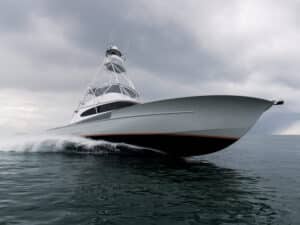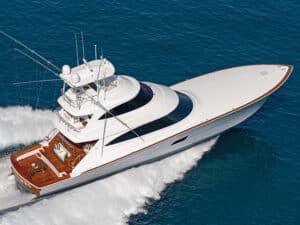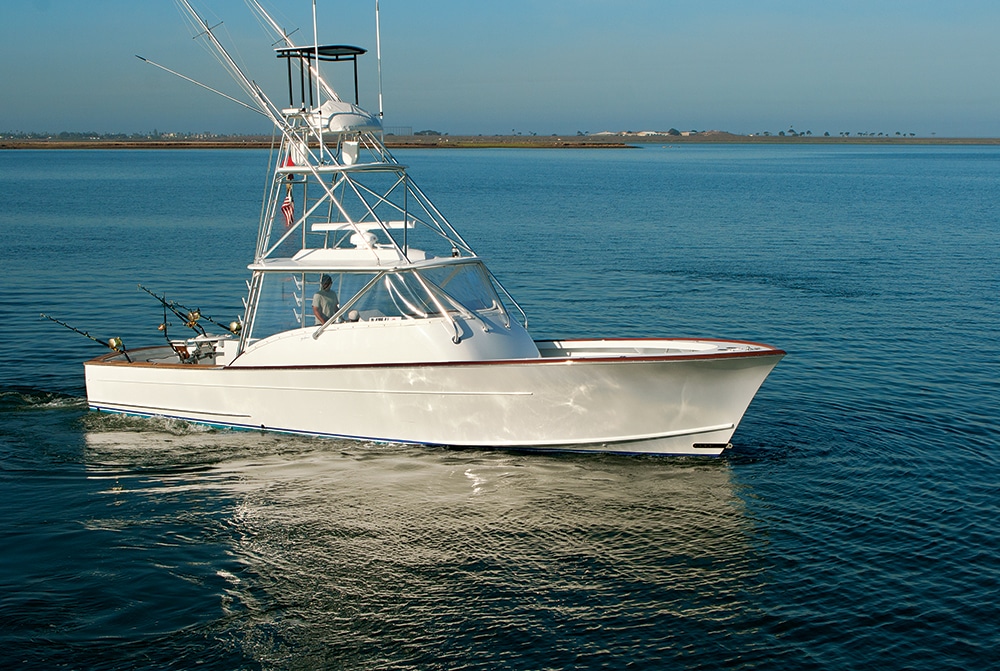
Ever since my first childhood dreams of owning a boat, I’ve always harbored a passion for the Walkaround design. I might not have known it at the time, but what I really loved was the versatility that comes with the layout. So it came as no -surprise that I instantly fell in love with the Gamefisherman 42 Walkaround.
Capt. Javier Bolanas welcomed me aboard De La Rosa, which recently made the long haul from the Gamefisherman factory in Stuart, Florida, to her present location in Chula Vista Marina near San Diego, California, by truck. The customized 42-footer is destined to find her berth aboard a mothership, the 160-foot Compass Rose, for ocean transport and angling adventures around the world, thanks to a massive lift designed to nestle De La Rosa on the aft deck of Compass Rose.
But it was the little sister that left me awe-struck. Her immaculate interior and classic lines represented just the beginning of my infatuation with De La Rosa. The more I examined and experienced, the more I grew enamored of her features, performance and fishing abilities. In fact, about the only thing I did not like about the boat was that she was not mine!
According to Bolanas, the owner of the boat seems to love her, too: “My boss asked me to tell you that this boat is the jewel in the crown of a lifelong fishing dream.”

General Appearance
Form and function merge gracefully in this model, one of five versions in the Gamefisherman Walkaround Sportsman series, which also includes a 37, 39, 43 and outboard version of the 42.
The unbroken sheer line of the 42 Walkaround sweeps upward toward the flaring bow, unencumbered by rails or other protrusions. Heavy-duty stainless-steel pull-up cleats keep the extra-wide covering boards free of snags. Awlgrip-encapsulated mahogany trim rims the boat from amidships forward, and you’ll find the same treatment for the cap rail surrounding the elevated bridge deck. Unfinished teak covers the aft cockpit gunwales. A 13-foot, 2-inch beam provides ample stability.
Built using a cold-molded epoxy -system, the deep-V hull boasts 10 degrees of deadrise at the transom and a slight tumblehome design in the stern quarters, with extra rub rails just above the boot stripe aft to guard against dock rash.
A hardtop completely shelters the 8-foot-wide bridge deck, with a Furuno 48 nm open-array antenna and twin Rupp aluminum outriggers mounted above. Electric teaser reels rest neatly in a special compartment above the helm.
De La Rosa‘s bridge deck features a clear-vinyl enclosure stretching from the hardtop to the rail cap. A dedicated air-conditioning system — one of two available on this boat — keeps everyone cool.
The central helm pod features throttle/shift levers on each side and a pop-up instrument panel with a Furuno NavNet TZtouch 14-inch multifunction display, a joystick for the Lewmar bow thruster and switches that control the automatic sync/slow-vessel mode on the twin 575-hp Caterpillar C9s. To monitor the engines, a Caterpillar marine-power display sits directly forward of the wheel. An overhead electronics box contains a Furuno VHF radio, NavPilot 711 auto-
pilot and RD33 electronic-compass display.
Rather than a captain’s chair, Bolanas prefers a pedestal stool, which allows him to spin around quickly and to see the action in the cockpit when things heat up.
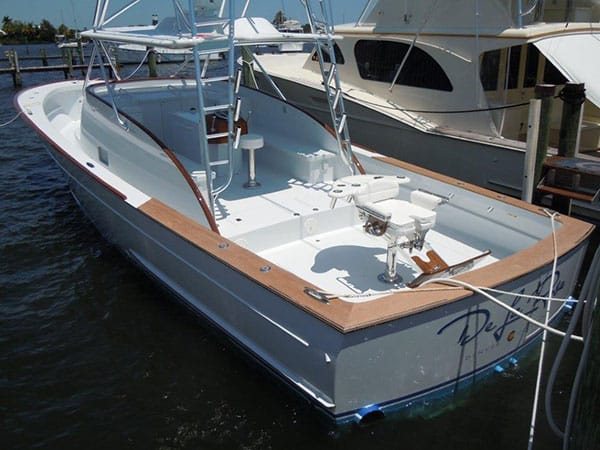
Cockpit
When asked why the boat’s owner chose a Walkaround cockpit design instead of an express layout, Bolanas replied with one word: versatility. “In addition to marlin, we like to fish for dorado, sails, tuna, wahoo and sometimes inshore species such as roosterfish,” Bolanas says. “Sometimes we troll, sometimes we cast, sometimes we kite fish, sometimes we drift. The Walkaround cockpit design expands our angling opportunities.”
When marlin fishing with stand-up tackle, Bolanas sometimes likes to chase fish going forward rather than backing down. “In rough seas, it proves safer and easier on the boat,” he explained.

With the exception of the bridge, the 42 Walkaround features a level deck from bow to stern with a fiberglass nonskid sole throughout and stainless-steel scupper drains amidships and aft, which help to shed green water quickly.
The Walkaround path offers ample foot room, ranging from 14 inches wide aft to 22 inches wide forward. The deck in the bow area is expansive, measuring 9 feet at its widest and 9 feet along the centerline.
The aft cockpit offers even more room to serve as battle central. You’ll find an insole livewell and a fish box, and our boat was fitted with a tuna-tube module forward of the fighting chair with four tubes, using inserts to accommodate small or large baits.
Cabin/Galley
One sacrifice you make with a Walkaround is less cabin space, but with the De La Rosa‘s mothership offering all the comforts of home, nobody’s complaining. The 42 Walkaround features a step-down cabin with a varnished teak floor leading to a cozy forward V-berth with room for two adults.
With a second air-conditioning system for the cabin area, you’ll stay comfy in the tropics, but the low ceiling might feel a bit claustrophobic. If the V-berth is occupied, two adults can also snooze on the bridge deck. It’s bookended by padded loungers upholstered in white vinyl, which resist stains from errant fish blood. Reversible padded backrests in the loungers allow passengers to face aft or forward.
Getting back to the cabin: It also -features an enclosed head on the starboard side with a marine toilet, a stainless-steel sink and a shower. Aboard De La Rosa, the shower stall is not likely to see much use, so it is also cleverly equipped with rod racks to stow heavy outfits vertically— sans bent butts. This allows for a convenient freshwater rinse at the end of the day.
The cabin features an abbreviated g-alley to port with marble countertops, a sink with a freshwater faucet and a built-in, top-loading refrigerator/freezer. A small microwave is tucked inside the cabinets below the counter.

Tower
De La Rosa features a full tower with an anodized-aluminum frame, a complete second station and a fiberglass sunshade aloft. To help reduce glare for the lookout, the frame for the sunshade features a black finish. Slip-resistant steps along the uprights offer easy access up or down. In an interesting touch, you can remove the portion of the tower above the hardtop by removing only four Allen bolts. This could be helpful when entering a remote port with low bridges. However, that feature was originally designed so De La Rosa could clear overpasses and electrical lines when she was trucked cross-country.

Engine Room
The 42 Walkaround offers two access points to the engine room. The first way is via an electrically operated hatch under the helm pod. This lets you step down to a -narrow catwalk between the mains. With the hatch elevated, you have sufficient headroom. Move aft along the catwalk to get to the generator in the back of the engine room. The second access point is through a hatch right in front of the helm pod, with the foldout steps on the forward bulkhead making it easy to get in and out. Abundant LED lighting offers great illumination for inspecting and servicing items in the engine room. I found the rigging to be immaculate, and, as you would expect on a boat that has seen little running time, the room itself was clean as a whistle.
Performance
At 22,500 pounds, De La Rosa is relatively light. With the low-end torque of the twin Cats and 32-inch-pitch four-blade propellers, she leaps out of the hole so quickly that you’d better be sitting down or hanging out when the captain advances the throttles.
She cruises nicely at 1,500 rpm and 20.6 knots, with fuel-burn rate of 19.2 gph, resulting in 1.07 nmpg, providing a maximum range of 371 nautical miles based on the 350-gallon fuel tank. At a top speed of 39.3 knots, the boat used 56.6 gph and mileage was 0.61 nmpg at wide-open throttle.
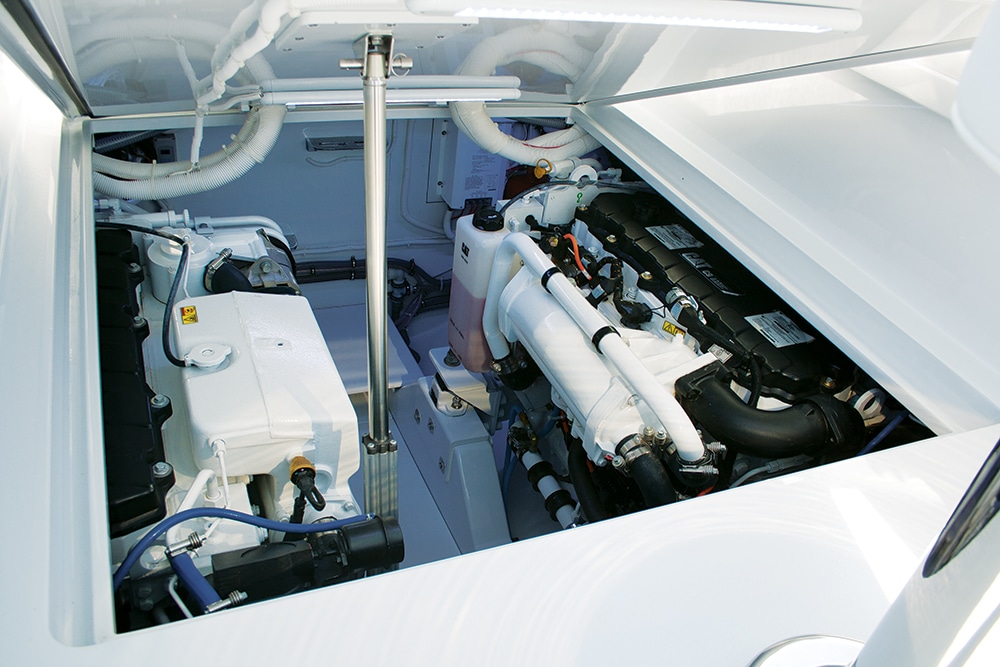
De La Rosa knifed smoothly and comfortably across the choppy waters of San Diego Bay. I sensed a solid confidence and felt nary a rattle or creak when we bounded over big wakes left by passing freighters.
For slow-trolling, Bolanas likes to use the Caterpillar slow-vessel mode, which reduces the engine idle speed to 540 rpm, down from the normal 700 rpm. With one engine in gear, this results in a speed of 4.7 knots; with both engines in gear, the boat trolls at 5.4 knots. At 700 rpm, De La Rosa trolls 7.5 knots. The boat lays down a clean wake with minimal white water at speeds of up 11 knots, creating clear trolling lanes.
Gamefisherman should be applauded for building a first-class fishing machine that you can use to pursue marlin, in addition to chasing just about any other species — an important attribute for a boat designed to travel the world in a quest for angling adventure. This Walkaround beauty will soon leave San Diego for the rich waters of Costa Rica, and with her, she will take my heart.
